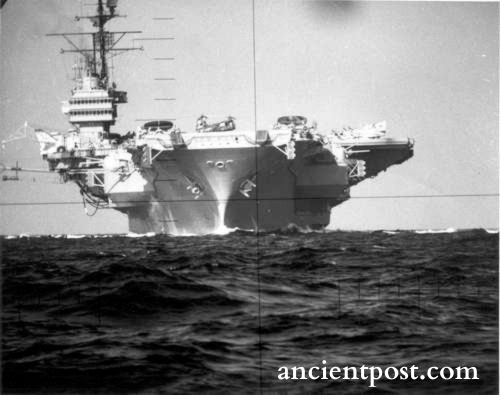Prelude
In the annals of the Cold War history, numerous intriguing incidents punctuate the tense relationship between the United States and the Soviet Union. One such event took place exactly forty years back, involving an unexpected collision between a Soviet submarine and a US aircraft carrier. This unexpected incident left a significant mark on the maritime history of the two superpowers, and its ripples are felt even today.

The Soviet Submarine K-314
The submarine involved in this incident was the Soviet submarine K-314. This nuclear submarine belonged to the Victor I class, known as Project 671 “Yorsh” in the Soviet Union. Launched on March 28, 1972, it was a marvel of the Soviet engineering prowess of that era.
The submarine was designed for a displacement of approximately 3,500 long tons when surfaced and about 4,750 long tons when submerged. It was about 94.3 meters long with a beam of 10 meters and a draft of 7.3 meters. Propelled by a single OK-300 pressurized water reactor, the submarine could achieve a speed of 24 knots and could dive up to 350 meters.
The Day of the Incident
It was March 21, 1984. The US Navy aircraft carrier USS Kitty Hawk was sailing in the Sea of Japan. Suddenly, the sailors aboard the carrier felt a sudden jolt. What they initially didn’t know was that their 80,000-ton ship had collided with the 5,200-ton Soviet submarine K-314.
The collision was unexpected and surprising, given that the Cold War tensions were at their peak during this period. The incident was further complicated by the fact that the submarine was in the vicinity of the carrier for the purpose of spying, a common practice during the Cold War.
Collision Aftermath
The impact of the collision was severe for the Soviet submarine. The K-314, which usually accommodated around 90 crew members, was following a Soviet guided-missile cruiser when the accident occurred. The submarine sustained significant damage, and, according to initial reports, it appeared as if the conning tower had been destroyed and the submarine’s body was cut to pieces.
The damage was so severe that the submarine was unable to move under its own power. The Soviet missile cruiser accompanying the submarine declined the American offers of assistance. The Kitty Hawk, on the other hand, escaped with a minor superficial dent and immediately resumed operations after the collision.
The Aftermath for the Submarine K-314
The fate of the submarine K-314 was unfortunate. The initial impact of the collision rolled the submarine onto her back, sparing the sail, periscope, and antennas. A second strike broke loose a blade of her propeller, which remained lodged in Kitty Hawk’s hull.
Divers reportedly removed a piece of the broken blade as a souvenir and samples of the submarine’s hull coating were examined for intelligence purposes. The commander of the submarine, Capt. Vladimir Evseenko, was removed from his post after the incident and transferred to land operations.
The Aftermath for the USS Kitty Hawk
Meanwhile, the USS Kitty Hawk continued to serve in the US Navy for another 25 years before finally being decommissioned in 2009. In 2021, the Navy made a recycling deal with a shipbreaking company to scrap the conventionally powered aircraft carrier. The following year, the large warship made its final voyage to a facility in Brownsville, Texas, where it is currently being scrapped.
The Larger Context
This incident was the third instance of a Soviet warship colliding with a US military vessel in a span of just five months. In October 1983, a Soviet submarine had to be towed to Cuba after it interfered with a US frigate’s sonar device and was disabled.
Despite an agreement between the Soviets and the US in 1972, pledging not to interfere with each other’s naval operations, accidents continued to happen. A major collision occurred in November 1974 when American and Soviet nuclear submarines ran into one another near Scotland, nearly sinking each other.
The Everlasting Impact
Such incidents at sea still occur, decades after the Cold War. The last time American military vessels collided with a foreign ship or submarine was in 2017. However, the collision involving the Soviet submarine K-314 and the USS Kitty Hawk remains one of the most significant incidents, highlighting the tensions and the risks associated with military operations during the Cold War era.
FAQs
1.Was the incident a deliberate act of aggression?
No, the incident was an unintended collision resulting from course deviation.
2.How long did it take to rescue the crew of the K-219?
The rescue operation took several hours to complete due to the challenging conditions posed by the submarine’s compromised integrity.
3.What were the long-term implications of the collision?
The collision played a significant role in the development of submarine technologies and safety protocols, ultimately enhancing maritime safety.
4.Did the incident significantly change the course of the Cold War?
While the incident did not dramatically alter the course of the Cold War, it further escalated tensions between the United States and the Soviet Union.
5.Are there any books or documentaries about the collision?
Yes, several books and documentaries have been published, providing detailed accounts of the collision and its implications.
